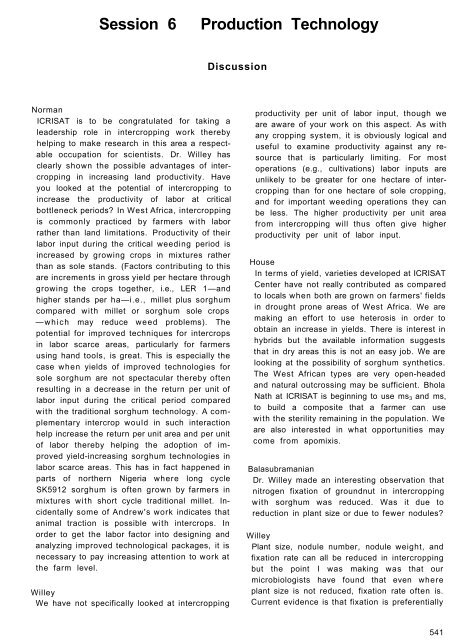RA 00048.pdf - OAR@ICRISAT
RA 00048.pdf - OAR@ICRISAT
RA 00048.pdf - OAR@ICRISAT
You also want an ePaper? Increase the reach of your titles
YUMPU automatically turns print PDFs into web optimized ePapers that Google loves.
Session 6<br />
Production Technology<br />
Discussion<br />
Norman<br />
ICRISAT is to be congratulated for taking a<br />
leadership role in intercropping work thereby<br />
helping to make research in this area a respectable<br />
occupation for scientists. Dr. Willey has<br />
clearly shown the possible advantages of intercropping<br />
in increasing land productivity. Have<br />
you looked at the potential of intercropping to<br />
increase the productivity of labor at critical<br />
bottleneck periods? In West Africa, intercropping<br />
is commonly practiced by farmers with labor<br />
rather than land limitations. Productivity of their<br />
labor input during the critical weeding period is<br />
increased by growing crops in mixtures rather<br />
than as sole stands. (Factors contributing to this<br />
are increments in gross yield per hectare through<br />
growing the crops together, i.e., LER 1—and<br />
higher stands per ha—i.e., millet plus sorghum<br />
compared with millet or sorghum sole crops<br />
—which may reduce weed problems). The<br />
potential for improved techniques for intercrops<br />
in labor scarce areas, particularly for farmers<br />
using hand tools, is great. This is especially the<br />
case when yields of improved technologies for<br />
sole sorghum are not spectacular thereby often<br />
resulting in a decrease in the return per unit of<br />
labor input during the critical period compared<br />
with the traditional sorghum technology. A complementary<br />
intercrop would in such interaction<br />
help increase the return per unit area and per unit<br />
of labor thereby helping the adoption of improved<br />
yield-increasing sorghum technologies in<br />
labor scarce areas. This has in fact happened in<br />
parts of northern Nigeria where long cycle<br />
SK5912 sorghum is often grown by farmers in<br />
mixtures with short cycle traditional millet. Incidentally<br />
some of Andrew's work indicates that<br />
animal traction is possible with intercrops. In<br />
order to get the labor factor into designing and<br />
analyzing improved technological packages, it is<br />
necessary to pay increasing attention to work at<br />
the farm level.<br />
Willey<br />
We have not specifically looked at intercropping<br />
productivity per unit of labor input, though we<br />
are aware of your work on this aspect. As with<br />
any cropping system, it is obviously logical and<br />
useful to examine productivity against any resource<br />
that is particularly limiting. For most<br />
operations (e.g., cultivations) labor inputs are<br />
unlikely to be greater for one hectare of intercropping<br />
than for one hectare of sole cropping,<br />
and for important weeding operations they can<br />
be less. The higher productivity per unit area<br />
from intercropping will thus often give higher<br />
productivity per unit of labor input.<br />
House<br />
In terms of yield, varieties developed at ICRISAT<br />
Center have not really contributed as compared<br />
to locals when both are grown on farmers' fields<br />
in drought prone areas of West Africa. We are<br />
making an effort to use heterosis in order to<br />
obtain an increase in yields. There is interest in<br />
hybrids but the available information suggests<br />
that in dry areas this is not an easy job. We are<br />
looking at the possibility of sorghum synthetics.<br />
The West African types are very open-headed<br />
and natural outcrossing may be sufficient. Bhola<br />
Nath at ICRISAT is beginning to use ms 3 and ms,<br />
to build a composite that a farmer can use<br />
with the sterility remaining in the population. We<br />
are also interested in what opportunities may<br />
come from apomixis.<br />
Balasubramanian<br />
Dr. Willey made an interesting observation that<br />
nitrogen fixation of groundnut in intercropping<br />
with sorghum was reduced. Was it due to<br />
reduction in plant size or due to fewer nodules?<br />
Willey<br />
Plant size, nodule number, nodule weight, and<br />
fixation rate can all be reduced in intercropping<br />
but the point I was making was that our<br />
microbiologists have found that even where<br />
plant size is not reduced, fixation rate often is.<br />
Current evidence is that fixation is preferentially<br />
541

















